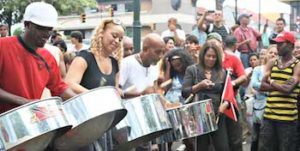
*On this date in 1502, we celebrate the Afro-Costa Rican community. They are Costa Rican citizens of African ancestry. History: The first recorded arrival of African descent in Costa Rica came with the Spanish conquistadors through the middle passage. Slave trade was common in all the countries conquered by Spain, and in Costa Rica, the first Black people came from African Equatorial and Western regions. The enslaved people were from the Gambia, Guinea, Ghanaians (Ashanti), Benin, and Sudan. Many of the enslaved people were Yoruba, from Ivory Coast and neighboring Panama.
The 17th and 18th centuries witnessed a gradual lessening of the differences between Blacks and their white owners. As whites took Black women as their concubines, they freed the children born from this union. The same thing started to happen with the "Zambos," born of indigenous and Black people. During slavery, the slaves worked on cattle ranches of Guanacaste and the Central Valley plantations and cacao plantations in Matina, whose situation was more difficult.
Over time, many whites freed their slaves, and slavery was abolished in 1823, along with the other Central American countries. Slavery was officially abolished in 1824. The largest Costa Rican Black community is from the Caribbean, which today constitutes much of the Costa Rican Black population. Costa Rica has the most prominent Jamaican diaspora after Cuba and Panama.
Since 1850, Afro Caribbean fishers began to settle in the Caribbean coast of Costa Rica, especially from Panama and the West Indies. They stayed in temporary camps during fishing seasons, from March to September, to plant coconuts, cassava, and yams harvested the following season. Since 1828, some of these fishermen began to settle in Costa Rica permanently with their families.
Towards the second half of the 19th century, coffee became the main export of Costa Rica. The crops were transported from the Pacific Coast by an inaccessible jungle terrain of the Atlantic Coast. They had to turn back to South America to reach Europe, increasing the cost and removing competitiveness. To respond, in 1871, they built a railway and a port on the Atlantic Coast. Because of the scarcity of local labor, workers were imported from Italy, China, the Caribbean, and Central America. This and an employment crisis in Jamaica caused an exodus. The following year, over 1,000 Jamaican workers came.
Many Jamaicans remained in the province of Limón on the Caribbean Coast. Later, they began working for the banana industry, whose production grew to its peak in 1907. Usually, these workers lived on the plantations and had little knowledge of Costa Rica. The contact was minimal; they did not speak Spanish and retained Jamaican customs. They had their schools with teachers brought from Jamaica.
Until 1949 Costa Rica had segregation laws where Blacks lived exclusively in the Caribbean Province of Puerto Limón. They were denied Costa Rican citizenship and thus the right to vote. By 2011 Afro Costa Ricans were spread in all 7 Costa Rican provinces: 32% of them in San José, 16% in Alajuela, 15% in Limón, 10% in Heredia and 8% in Cartago and Guanacaste. Today, Afro-Costa Rican people are part of different disciplines and fields in Costa Rica.
Costa Rica has four small nonwhite groups: Mulattoes, Blacks, Amerindians, and Asians (primarily Chinese/East Asian). About 8% of the population is of African descent or Mulatto (mix of European and African) who are called Afro-Costa Ricans. A large portion of this group descends from the late 19th and early 20th century waves of Afro Caribbean migrant workers (mainly from Jamaica).
They represent the largest group of Jamaicans living outside of Jamaica's Anglophone-dominated diaspora. However, not all Black Costa Ricans are descended from these groups, as some descended from colonial-era enslaved Africans imported to Costa Rica by the Spanish. This latter group, however, is more likely to be mulatto, or tri-racial.
Demographics Afro-Costa Rican's are 8 percent of the population, compared to 2.4 percent who are Amerindian and 83 percent of European heritage (including castizo and mestizo). In Guanacaste, a significant portion of the population is Afro mestizo, descended from a mix of local Amerindians, Africans, and Spaniards.